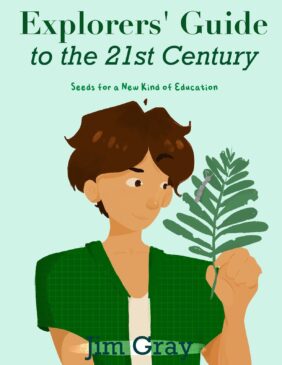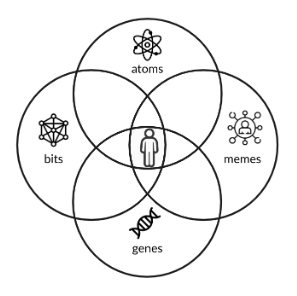
“What would Joan do” is a question children’s media professionals can ask as we explore the pedagogical possibilities of new digital tools. Early childhood researchers have long noted that children often “think like a scientist” as they explore novel materials or situations. Likewise, viewers may imitate their favorite television character, as when preschoolers try broccoli after seeing Elmo do the same. Children, youth, and individuals of all ages can learn to think and act like artists, authors, naturalists, mathematicians, philosophers, and more, given the right scaffolding — modeling, joint activity, apprenticeships, etc. In the process, they may gain useful skills, knowledge, and dispositions, especially when they learn to pivot among social roles to fit the needs of a given challenge.
This sort of social and parasocial learning is at the pedagogical heart of the Explorers’ Guide to the 21st Century, a participatory book project launching this month. Initially, it will be structured as a Kickstarter project, with one chapter (essay) shared each month for ten months, and an associated online community for discussing each set of ideas. I’m starting on Kickstarter because it’s a tried-and-true platform for finding and bringing together people with a common interest in a creative project. It is open to your participation and support. In this blog post, I outline the project and invite you to join.

Why am I doing this project? The content grows from my career-long experience at the intersection of human development and learning, technology innovation, and education reform. The format affords flexibility in both the creative process and follow-on steps. The associated online community supports extension and critique of the ideas, networking, and potential collaborations among members.
The Guide will appeal to educators, researchers, parents, and others with a commitment to preparing children and youth for our rapidly changing, high-stakes world of robotic automation, synthetic biology, political polarization, artificial intelligence, climate change, and more. It will describe a novel educational system designed from first principles of human development and learning to help the next generations survive and thrive in challenging times. It is designed as a fresh start, but is informed by current school improvement and informal education approaches and may contribute to them. The Guide will confirm some established principles of education and challenge others. Core learning goals include being flexibly adaptive, constructively collaborative, and wise.

The Guide is organized around a theme (building wisdom), curriculum (“self and world” from multiple perspectives), and pedagogy (learning archetypes, community-oriented projects). You could think of it as a kind of future school, designed to support self-directed learning, lifelong and lifewide, across institutions and cultures.
Essays:
Overview: Education Moonshot —How designing a new education system from first principles of human development and learning can leapfrog the barriers to school reform, provide a blueprint for future education design, and inspire short-term practical solutions to current needs.
Theme: Building Wisdom— Focus on a far-future orientation, understanding the past and current trajectories, honoring multiple perspectives, and doing social good.
Curriculum: Self and World — Center core skills in self knowledge and efficacy. Build the capacity to see and act from multiple perspectives; pivot as needed between different epistemologies. Explore first principles of the physical, living, social, and digital realms.
Pedagogies: Learning Archetypes, Constructionism, Learning Sciences — Social learning – people learn from people — is a first principle of human learning, which can be expressed across activities of domain-specific archetypes and community-oriented collaborative projects. This learning is consistent with fundamental pillars of learning science.
Athlete and Artist— Each in their own way, these archetypes model a process of physical and psychological centering.
Naturalist and Sage — These Archetypes represent two complementary ways of engaging the world.
Author and Mathematician-Logician — These represent two fundamental ways that human beings use symbolic systems to expand their experience and agency through time and space.
Scientist and Teacher —These Archetypes are engaged in processes that help adapt to changing conditions.
Philosopher-Theologian — This Archetype represents a broad epistemic project to ask, and perhaps answer, existential questions such as “Who am I?”, “Why am I here?”, and “What is it all about?” And, it may address emerging issues such as consciousness and artificial intelligence.
Conclusion and next steps — The final chapter of the Guide will be determined by the process of writing, sharing, and discussing the previous chapters/essays. That said, possible next steps include: Edit essays into a commercial book. Character bibles for children’s media and games. Graphic novels. A blueprint for education systems. A guide for research. Youth club akin to Scouting. An AI-based system of learning archetypes.

To learn more, participate in the discussion, or contribute financially, please see the Kickstarter Campaign for the Explorers’ Guide to the 21st Century. Thanks. I hope to see you there!
 Jim Gray is a teacher, parent, researcher, and author focused on learning and digital media. He has held leadership roles at multiple ground-breaking educational organizations (LeapFrog Inc., Sesame Workshop, MIT Media Lab). He has tween-age daughters and tries to make the future a little brighter. https://www.linkedin.com/in/jgray344/
Jim Gray is a teacher, parent, researcher, and author focused on learning and digital media. He has held leadership roles at multiple ground-breaking educational organizations (LeapFrog Inc., Sesame Workshop, MIT Media Lab). He has tween-age daughters and tries to make the future a little brighter. https://www.linkedin.com/in/jgray344/

